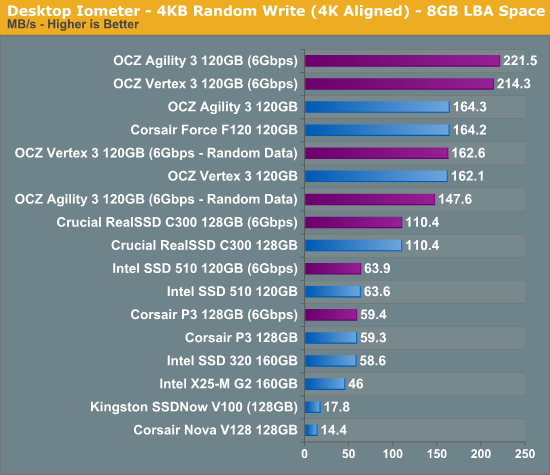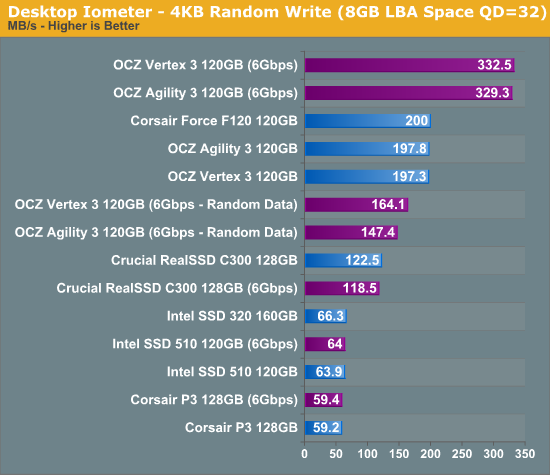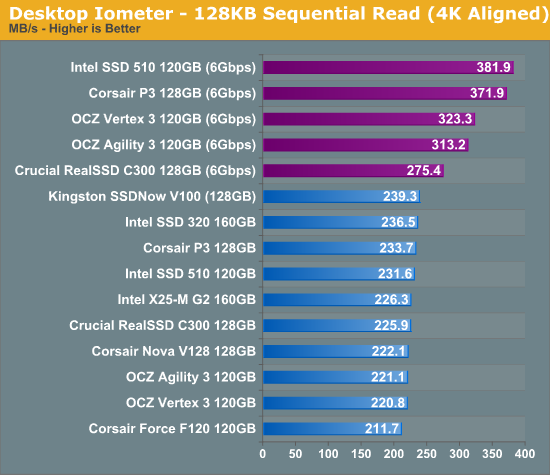The 2011 Mid-Range SSD Roundup: 120GB Agility 3, Intel 510 and More Compared
by Anand Lal Shimpi on June 7, 2011 12:52 PM ESTRandom Read/Write Speed
The four corners of SSD performance are as follows: random read, random write, sequential read and sequential write speed. Random accesses are generally small in size, while sequential accesses tend to be larger and thus we have the four Iometer tests we use in all of our reviews.
Our first test writes 4KB in a completely random pattern over an 8GB space of the drive to simulate the sort of random access that you'd see on an OS drive (even this is more stressful than a normal desktop user would see). I perform three concurrent IOs and run the test for 3 minutes. The results reported are in average MB/s over the entire time. We use both standard pseudo randomly generated data for each write as well as fully random data to show you both the maximum and minimum performance offered by SandForce based drives in these tests. The average performance of SF drives will likely be somewhere in between the two values for each drive you see in the graphs. For an understanding of why this matters, read our original SandForce article.

At worst, SandForce's small file random write performance is equal to its closest competitors, but at best it is significantly greater. Both the Vertex 3 and Agility 3 take the cake here. The Marvell based solutions are significantly slower, however we'll see if that matters in the real world tests.
Many of you have asked for random write performance at higher queue depths. What I have below is our 4KB random write test performed at a queue depth of 32 instead of 3. While the vast majority of desktop usage models experience queue depths of 0 - 5, higher depths are possible in heavy I/O (and multi-user) workloads:

At higher queue depths the advantage just grows for the SF-2281 drives.

Crucial optimized very heavily for random read performance, and to this day nothing (even the replacement m4/C400) can outperform the C300 in our small file random read test. Intel's SSD 510 is the next fastest 6Gbps drive we've got here, followed by the P3 and eventually the Vertex 3/Agility 3.
Sequential Read/Write Speed
To measure sequential performance I ran a 1 minute long 128KB sequential test over the entire span of the drive at a queue depth of 1. The results reported are in average MB/s over the entire test length.

To post high sequential read speeds you need to have a 6Gbps interface these days. Armed with one the Intel SSD 510 and Corsair P3 both post the highest scores here. Even the Vertex 3/Agility 3 are a bit behind the two Marvell drives.

Sequential write performance is another story entirely. With highly compressible data the Vertex 3 is untouched and even in the worst case it's still among the fastest drives. I'll chalk this one up as a win for OCZ, however the rest of the competitors do well here.










68 Comments
View All Comments
hybrid2d4x4 - Friday, June 10, 2011 - link
Slightly off topic question: in your review of the Agility 3, you guys mentioned that it's lower power characteristics are due to asynchronous NAND. Does the Agility 2 also use this?I want a SSD for a laptop I'm getting within the next 2 months and don't really care as much about performance, just power consumption and bang-for-buck.
tecsi - Monday, June 13, 2011 - link
Appears that Agility3 120GB << 240GB with incompressible data (which apparently is typical).Would we see yet another big performance drop for 60GB? Need to add this review so we can see what we lose.
Perhaps the value of SATA III drops precipitously with each halving of SSD capacity?
tecsi - Monday, June 13, 2011 - link
This would be helpful to see see "real world performance" in ONE place. For example, Agility 3 60GB, 120GB, 240GB and Vertex 3 120GB, 240GB.tecsi - Monday, June 13, 2011 - link
Incompressible Read Speed: Vertex3 (497) 2.5 times faster than Agility 3 (203)? Is this correct? What accounts for this huge difference?erikejw - Friday, July 15, 2011 - link
Beware the Intel SSD 320 (and probably 510 too).Huge number of complete data losses for users.
Intel finally admits the problem exist.
To my knowledge noone has been able to retrieve any data.
-------------------
http://www.fudzilla.com/memory/item/23447-intel-co...
-------------------
"Intel is aware of the customer sightings on Intel SSD 320 Series. If you experience any issue with your Intel SSD, please contact your Intel representative or Intel customer support (via web: www.intel.com or phone: www.intel.com/p/en_US/support/contact/phone) . We will provide an update when we have more information.
Alan
Intel's NVM Solutions Group"
datalaforge - Saturday, July 23, 2011 - link
Thanks for all of the great lineups here. I'm wondering what you guys think about the Samsung 470 SSD. Also why is the Seagate Momentus XT the only Hybrid drive that I can find out there. It seems like such a good idea. Why haven't any competitors given Hybrids a shot?Carlu - Friday, September 16, 2011 - link
A) Can some one explain to me the different in "8GB span" vs "100% span"?http://ark.intel.com/compare/56577,56576,56585,565...
B) And how do I compare them?
drumm_22 - Wednesday, June 6, 2012 - link
I have been reading several of the SSD articles on AnAnd and reading reviews on Newegg. I have recently purchased a Sager notebook to use during my college years as an engineering student. I was wondering if an SSD would be worth the money right now or should i wait for SSD's to become more adavanced at cheaper?